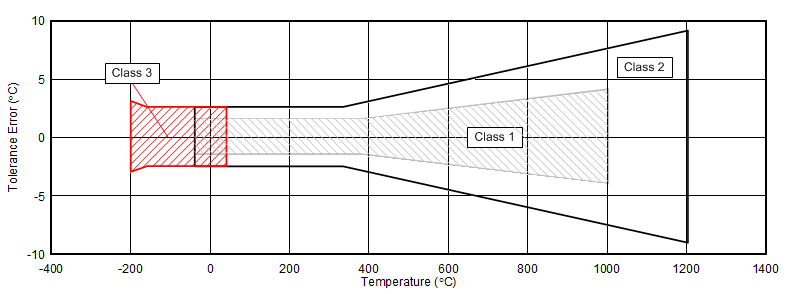SBAA274A September 2018 – March 2023 ADS1118 , ADS1119 , ADS1120 , ADS112C04 , ADS112U04 , ADS1146 , ADS1147 , ADS1148 , ADS114S06 , ADS114S06B , ADS114S08 , ADS114S08B , ADS1219 , ADS1220 , ADS122C04 , ADS122U04 , ADS1246 , ADS1247 , ADS1248 , ADS124S06 , ADS124S08 , ADS125H02 , ADS1260 , ADS1261 , ADS1262 , ADS1263
- A Basic Guide to Thermocouple Measurements
- Trademarks
- 1Thermocouple Overview
-
2Thermocouple Measurement Circuits
- 2.1 Thermocouple Measurement With Pullup and Pulldown Bias Resistors
- 2.2 Thermocouple Measurement With Biasing Resistors Attached to the Negative Lead
- 2.3 Thermocouple Measurement With VBIAS for Sensor Biasing and Pullup Resistor
- 2.4 Thermocouple Measurement With VBIAS For Sensor Biasing and BOCS
- 2.5 Thermocouple Measurement With REFOUT Biasing and Pullup Resistor
- 2.6 Thermocouple Measurement With REFOUT Biasing and BOCS
- 2.7 Thermocouple Measurement With Bipolar Supplies And Ground Biasing
- 2.8 Cold-Junction Compensation Circuits
- 3Summary
- 4Revision History
1.2.4 Tolerance Standards
Temperature measurement accuracy and range depend on the type of the thermocouple used and the standard followed by the manufacturer. The International Electrotechnical Commission standard outlined in IEC-EN 60584 contains the manufacturing tolerances for base metal and noble metal thermocouples. A parallel standard used in the United States from the American Society for Testing and Materials is described by ASTM E230. Table 1-4 shows the tolerance of different thermocouples based on different standards and tolerance classes.
| Thermocouple Type | Tolerance Class | Temperature Range (°C) | Thermocouple Error (°C) (Larger between two columns) | ||
|---|---|---|---|---|---|
| J | IEC-EN 60584-2 | Class 1 | –40 < T < 750 | ±1.5°C | ±(0.004 · |T|) |
| Class 2 | –40 < T < 750 | ±2.5°C | ±(0.0075 · |T|) | ||
| Class 3 | – | – | – | ||
| ASTM E230 ANSI MC96.1 | Special | 0 < T < 750 | ±1.1°C | ±(0.004 · |T|) | |
| Standard | 0 < T < 750 | ±2.2°C | ±(0.0075 · |T|) | ||
| K | IEC-EN 60584-2 | Class 1 | –40 < T < 1000 | ±1.5°C | ±(0.004 · |T|) |
| Class 2 | –40 < T < 1200 | ±2.5°C | ±(0.0075 · |T|) | ||
| Class 3 | –200 < T < 40 | ±2.5°C | ±(0.015 · |T|) | ||
| ASTM E230 ANSI MC96.1 | Special | 0 < T < 1250 | ±1.1°C | ±(0.004 · |T|) | |
| Standard | –200 < T < 0 0 < T < 1250 | ±2.2°C ±2.2°C | ±(0.02 · |T|) ±(0.0075 · |T|) | ||
| T | IEC-EN 60584-2 | Class 1 | –40 < T < 350 | ±0.5°C | ±(0.004 · |T|) |
| Class 2 | –40 < T < 350 | ±1.0°C | ±(0.0075 · |T|) | ||
| Class 3 | –200 < T < 40 | ±1.0°C | ±(0.015 · |T|) | ||
| ASTM E230 ANSI MC96.1 | Special | –200 < T < 0 0 < T < 350 | ±0.5°C ±0.5°C | ±(0.008 · |T|) ±(0.004 · |T|) | |
| Standard | –200 < T < 0 0 < T < 350 | ±1.0°C ±1.0°C | ±(0.015 · |T|) ±(0.0075 · |T|) | ||
| E | IEC-EN 60584-2 | Class 1 | –40 < T < 800 | ±1.5°C | ±(0.004 · |T|) |
| Class 2 | –40 < T < 900 | ±2.5°C | ±(0.0075 · |T|) | ||
| Class 3 | –200 < T < 40 | ±2.5°C | ±(0.015 · |T|) | ||
| ASTM E230 ANSI MC96.1 | Special | –200 < T < 0 0 < T < 900 | ±1.0°C ±1.0°C | ±(0.005 · |T|) ±(0.004 · |T|) | |
| Standard | –200 < T < 0 0 < T < 900 | ±1.7°C ±1.7°C | ±(0.01 · |T|) ±(0.005 · |T|) | ||
| S | IEC-EN 60584-2 | Class 1 | 0 < T < 1600 | ±1.0°C | ±[1 + 0.003 · (|T| – 1100)] |
| Class 2 | –40 < T < 1600 | ±1.5°C | ±(0.0025 · |T|) | ||
| Class 3 | – | – | – | ||
| ASTM E230 ANSI MC96.1 | Special | 0 < T < 1450 | ±0.6°C | ±(0.001 · |T|) | |
| Standard | 0 < T < 1450 | ±1.5°C | ±(0.0025 · |T|) | ||
As an example, Figure 1-4 graphically shows the error of a type-K thermocouple with the IEC-EN 60584-2 tolerance classes. At higher temperatures, the thermocouple error becomes significantly greater.
 Figure 1-4 Type-K IEC-EN 60584-2 Tolerance Class Errors
Figure 1-4 Type-K IEC-EN 60584-2 Tolerance Class ErrorsThermocouples show a wide range of error dependent on the tolerance class. However, few of these thermocouples have error tolerances better than ±1°C. For this reason, RTDs are preferred for applications requiring higher precision and accuracy. It common to use 16-bit ADCs for thermocouple measurements and 24-bit ADCs for RTD measurements.